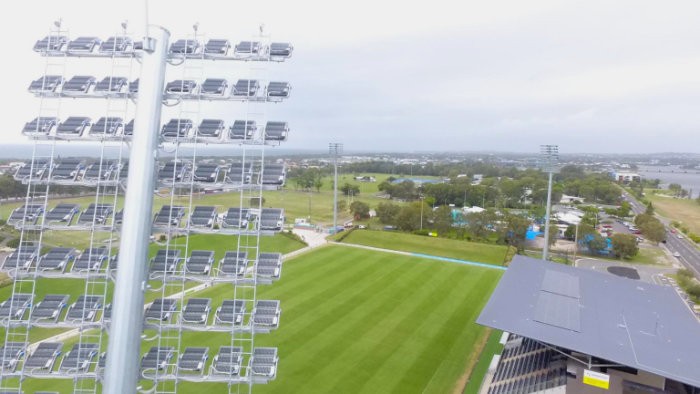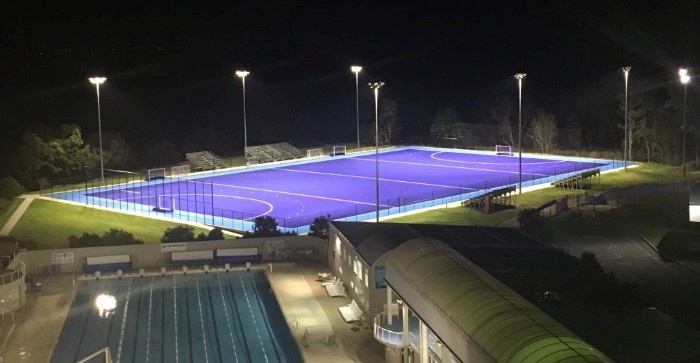Sports Lighting Considerations
Adequate Lighting
Adequate lighting is a fundamental necessity for every sporting venue across Australia. Sports clubs depend on appropriate lighting to ensure players of all ages and skill levels can safely participate, regardless of the time or lighting level. Carefully planned and designed sports lighting systems guarantee consistent, bright conditions for all sections of the playing area. Therefore, it is imperative that some key points are considered such as the operating costs, compliance with permits and Australian standards and the effects on residents nearby.
We will discuss, advise and guide you through the leading considerations for sports lighting to avoid any potential issues down the line. Our team of professionals service Greater Brisbane, Gold Coast and Sunshine Coast. If you have any questions or queries regarding sports lighting and the process involved, please contact us on 1300 054 488 or enquire here
All services
Planning and approvals
Planning Permits
First of all, if you are seeking to use or develop land, ensure you discuss the proposition with your local council planning and recreating departments. These discussions should tell you whether or not you will need a planning permit. Usually, you will not require a planning permit if you are wishing to upgrade the sports lighting.
During this planning permit process, you may need to consult residents that have property surrounding the area. It is advisable to discuss your sports lighting plan with local residents and other stakeholders to help avert any concerns they may have.
Your local council’s Planning Permit Application form should be completed and submitted with the permit application fee for your state. All appropriate supporting information, such as plans, reports and photos should also be submitted.
Ground conditions
It is wise to have the soil conditions tested prior to application as contaminated soil requires special considerations. Many sports fields are actually situated over landfill sites or flood plains, which can make the foundations for the sports lighting poles more complicated constructions and therefore increase the overall cost of the project.
Light spill
When planning your new sports lighting, you should give consideration to the residential houses nearby that may be affected by the light that will fall outside of the sports field. Planning permits usually require evidence of how much light will spill onto neighbouring houses. A clear and concise way to do this would be in the form of an isolux diagram. You may also need to consider if there could be traffic or aviation lighting spill requirements to fulfil in your area as well.
Building permits
The installation of lighting poles usually requires a building permit, whether a planning permit is needed or not. Your local council will need to give permission for any work that you wish to carry out if they are the landowner. A permit is needed when lighting poles of over 8m high, and not attached to a building, are to be installed; as stated in your state’s Building Regulations 2021.
Potential impact of aviation
When planning for the installation of sports lighting, you must consider the proximity to any airports as restrictions are usually in for up to 6km from airport runways.

Design considerations
Power supply
It is key to speak to your local electricity company, as early in the project as possible, to organise a new, or upgraded, power supply for the proposed lights. You need to ensure that the power supply requirements for your new lights can be met, but also that if the lux levels increase in the future, it is enough to continue to power the lights. Also, the switchboard must have the capacity to cope with the new requirements.
It is also important to consider who is going to be paying for the power. Now this may seem like a silly point, but will the usage be split between different clubs? Will the new lighting be on a separate metered account or will you install a check meter to log the usage or will each club / team be billed for typical usage patterns? If you are thinking about billing for typical usage patterns then you also need to factor in that competition levels of lighting will be higher than training levels. Furthermore, the start up of the sports lights usually needs a higher demand for power so this will need to be accounted for. Not so simple, is it?!
Lighting control
How will the lights be controlled? You may obviously by thinking “by the light switch” and yes, that does cover the fundamentals of the matter but, it goes deeper than that. The lighting can be controlled by a switch on each pole or with a switch for each pole in a central location, which would be easier. These switches need to be guarded somehow though to stop anyone from using them without permission and leaving your club with a hefty power bill that you didn’t run up. We propose keeping the light switches either:
- Located in a locked cabinet / box or
- Implementing key-operated switches
No matter which option suits you best, both should be located in an area with controlled access. If you would like to avert any potential key-loss situations, apps are available, for registered people, to turn the lights on and off.
Types of lighting
There are currently 2 types of bulbs that are most commonly used for sports lighting:
- HID Metal Halide
- Light Emitting Diode (LED)
Metal Halide lights, such as fluorescent tubes, are referred to as ‘discharge lamps’ as the gas inside the lamp glows, as opposed to the filament like in a halogen bulb. This makes Halides more efficient than halogen, but their light output tends to decrease 25% within 250 hours! Also, when halides switch off, they take a significant time to re-start, leaving you in darkness for part of the training session (we speak from experience). Although Halide bulbs are cheap and economical, their maintenance costs can actually end up being greater as the bulbs need to be replaced much more frequently, and this isn’t a simple task when they’re 25m high!
LED lights are the current choice for many sports lighting installations. LEDs provide up to 60% energy savings as well as having a substantially longer lifespan and allowing for much more precision illumination.

Maintenance and operation
Lamp replacement
It is worth creating an operation and maintenance manual when you are installing new lights. This should be a clear policy outlining how frequently the lights will be cleaned and other maintenance instructions in line with the manufacturer’s recommendations. There should also be policy regarding the replacement of bulbs and a sinking fund to finance replacements and maintenance requirements.
Manufacturers will advise on the lifespan of their bulbs, but this can be dependent on certain usage practices and so if the lights are switched on more frequently etc, this can vary. This life expectancy can help you forecast when the lights will need to be replaced, before they stop working and training is cancelled!
Factors affecting the lifespan of a bulb include:
- The depreciation of the light output over time
- The reduction of the light output due to dirt and residue on the lights
Light aiming
The aiming of sports lights when they are installed has a significant effect on their performance and this is a common aspect of poor light performance. This is why it is a key component to ensure a professional undertakes the light aiming with their precise equipment; and the measurements should be recorded for future reference.
Environmentally sustainable design
As lights age, their luminosity can diminish over time. To account for this natural decline in brightness, you must factor-in a ‘Light Loss Factor’ (LLF) when planning lighting systems. Based on average outdoor conditions, 0.8 to 0.7 is the recommended LLF used during design calculations (as long as regular maintenance is performed).
To optimise the environmental sustainability of the sports lights, there are several elements to consider:
- Sports light quantity – more lights need more power
- Use energy efficient lights with a high Light Loss Factor (circa 0.8)
- Control gear (CG) optimises the energy consumption of the bulbs throughout their lifespan. However, CG also uses energy (50 – 150 Watts), which needs to be in your energy consumption calculations.
- Duration of use – timers or key switches can reduce usage to approved people only
Professional sports lighting specialists
If you would like to discuss any of the considerations above, or simply to ask advice on sports lighting, please contact one of our friendly team today on 1300 054 488 or complete our online enquiry form.
With over 40 years in delivering quality lighting projects, you can be sure Australian Sports Lighting Solutions can be trusted to give constructive advice and deliver results for your next lighting project.
References:
AS 2560.1 – Sports lighting General Principles
AS 4282 – Control of the obtrusive effects of outdoor lighting
QLD Government Sports Field Lighting Factsheet
NSW Football Facilities Lighting Guide
Trusted by over 7,400 reviewers on Google.
Rated 4.6 stars from more than 7,400 reviews in Brisbane


